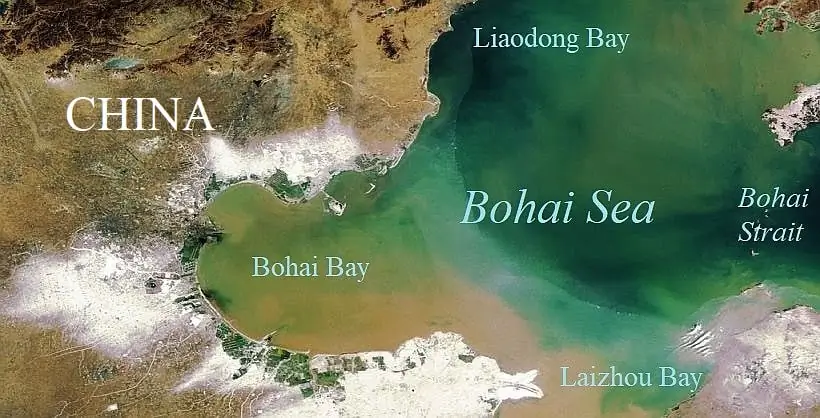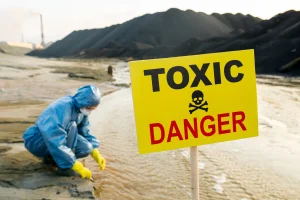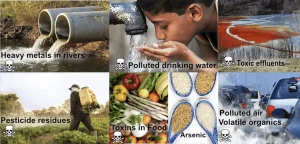Pollution hotspots are areas which are subject to particularly severe pollution loads. We mainly find them in enclosed or semi-enclosed bodies of water like bays or river mouths where water exchange is restricted, leading to the accumulation of pollutants.
The Bohai Sea is a pollution hotspot, a semi-enclosed sea in northeast China and one of the busiest seaways in the world. Since the 1970’s, and most notably in the last two decades, extremely rapid urbanisation and industrialisation has led to intense contamination from the coastal regions surrounding the Bohai Sea. Oil exploitation, port area activities, industrial waste draining, domestic sewage and atmospheric subsidence contribute to the pollution. Various rivers, such as the Yellow River, also carry pollutants from inland sources, discharging them into the Bohai.
1. Heavy Metals as Pollutants
Amongst the pollutants are heavy metals, such as lead, Pb, and mercury, Hg (see our article on ‘Toxic heavy metals’ for more detail). Toxic heavy metal species can provoke changes in the structure and function of environmental ecosystems, inducing eutrophication and red tides and increasing the mortality of fishes and benthos.
In such areas, the consumption of local seafood has become a public health threat and decreased fishery yield has impacted the economy. Furthermore, heavy metal discharge may also pollute coastal soil. This can lead to contaminated crops, further increasing human exposure to the heavy metals. Concentrations of different heavy metals in estuarine water samples from the southern Bohai Sea have been found to greatly exceed World Health Organisation (WHO) limits, represented in the table below. However, to assess which heavy metal and which metal species pose the most serious health risk across the Bohai requires comprehensive chemical speciation analyses.
Table 1: Concentration data of some heavy metals found to exceed WHO (World Health Organisation) guidelines in estuarine water. From: Wang et al. (2010).
| Element | WHO Limit (ppb) | Maximum measured seawater concentration (ppb) |
| Copper | 2000 | 2755 |
| Arsenic | 10 | 347.7 |
| Cadmium | 3 | 6.26 |
2. Speciation in Pollution
Many of the discharged pollutants form dissolved ions in water which are readily scavenged by suspended clays and oxide particles. These particles subsequently fall and form a sedimentary repository rich in heavy metals at the seabed. Therefore, the threat of heavy metal pollution is not only dictated by the metal’s total concentration but also by its binding affinity to the sediment. This binding affinity is determined by the particular structural and electronic properties of metal species and the type of sediment particles. Dissolved metal species and free metal ions can be absorbed easily by microorganisms and living tissues (i.e. they are bioavailable), making these species potentially toxic. Metals that are bound to sediment particles can be released back to the water column upon changes in water chemistry.
Apostichopus japonicus: a species of sea cucumber in the family Stichopodidae
This has environmental and health implications. For example, Apostichopus Japonicus, commonly known as sea cucumber and found only in the coast of the Yellow and Bohai seas, feeds on organic matter in the sediments, which can contain Cu2+. In low quantities, the ionic species is essential for life, but high concentrations caused by pollution force the sea cucumber to spend a lot of its energy into the metabolism of Cu2+ to avoid being poisoned. This may limit the sea cucumber’s as well making it toxic to consume. Since the sea cucumber is considered a precious seafood in Chinese cuisine, it poses a clear risk to the local people.

Zooplankton assemblage example
Does this evidence suggest that cadmium is the key heavy metal presenting the greatest health risk in the Bohai Sea? Biological impact can be a good indicator. Analysis of zooplankton assemblages at estuarine sites found that, statistically, cadmium was the pollutant with the single greatest influence on the distribution of zooplankton species. However, contrary to this evidence, environmental risk assessments from other researchers suggest that cadmium poses an ‘acceptable’ risk, while mercury and lead pose the ‘highest’ threat in Bohai seawater.
Heavy metal speciation over the entirety of this pollution hotspot has been sparsely investigated. Conditions such as pH, temperature, wave action and organic matter that allow cadmium to exist as bioavailable complexes in coastal regions may differ throughout the semi-enclosed sea. A region-wide seawater chemical speciation study would elucidate the concentrations of different dissolved heavy metal species, highlighting which of these species poses the greatest threat to the wider ocean system, beyond their riverine and coastal origins.
Please cite this article as: “Nanolyse (2023), The Bohai Sea: A Pollution Hotspot? Nanolyse Technologies Ltd, Oxford, UK.”
Further Reading
- Gao, X., Zhou F., & Chen, C. A. (2014). Pollution status of the Bohai Sea: An overview of the environmental quality assessment related trace metals. Environmental International 62, 12-30. https://doi.org/10.1016/j.envint.2013.09.019
- Gao, Y., Yang, Q., Li, H., Wang, X., & Zhan, A. (2019). Anthropogenic pollutant-driven geographical distribution of mesozooplankton communities in estuarine areas of the Bohai Sea, China. Nature Scientific Reports, (October 2018), 1–12. https://doi.org/10.1038/s41598-019-46047-5
- Li, Y., Guo, L., & Feng, H. (2015). Status and Trends of Sediment Metal Pollution in Bohai Sea, China. Current Pollution Reports, 191–202. https://doi.org/10.1007/s40726-015-0021-1
- Luo, W., Lu, Y.L., Wang, T.Y., Hu, W.Y., Jiao, W.T., Naile, J.E., Khim, S.K., & Giesy, J.P. (2010). Ecological risk assessment of arsenic and metals in sediments of coastal areas of northern Bohai and Yellow Seas, China. Ambio, 39, 367-375. https://doi.org/10.1007/s13280-010-0077-5
- Wang, J., Chen, S., & Xia, T. (2010). Environmental risk assessment of heavy metals in Bohai Sea , North China. Procedia Environmental Sciences, 2(5), 1632–1642. https://doi.org/10.1016/j.proenv.2010.10.174
- Xu, L., Wang, T., Ni, K., Liu, S., Wang, P., Xie, S., & Meng, J. (2013). Metals contamination along the watershed and estuarine areas of southern Bohai Sea, China. Marine Pollution Bulletin, 74, 453–463. https://doi.org/10.1016/j.marpolbul.2013.06.010
- Xu, L., & Li, J. (2015). Speciation and Degrees of Contamination of Metals in Sediments from Upstream and Downstream Reaches along the Catchment of the Southern Bohai Sea, China. International Journal of Environmental Research and Public Health, 7959–7973. https://doi.org/10.3390/ijerph120707959
- Zhang, A., Zhang, D., Pei, S., Duan, G., Feng, X., Zhang, Y., & Wu, J. (2020). The Pollution Level, Spatial and Temporal Distribution Trend and Risk Assessment of Heavy Metals in Bohai Sea of China. Journal of Coastal Research 115, 354-360. https://doi.org/10.2112/JCR-SI115-105.1
- Li JunFeng, W. Wei, Zhang Sai-sai, Wang Hua, X.Huan, Shen Shuangye, He Xu-ying, Wang Bing (2014). Effects of chronic exposure to Cu2+ and Zn2+ on growth and survival of juvenile Apostichopus japonicus. Chemical speciation & Bioavailability 26, 106-110. https://doi.org/10.3184/095422914X13953450663379




